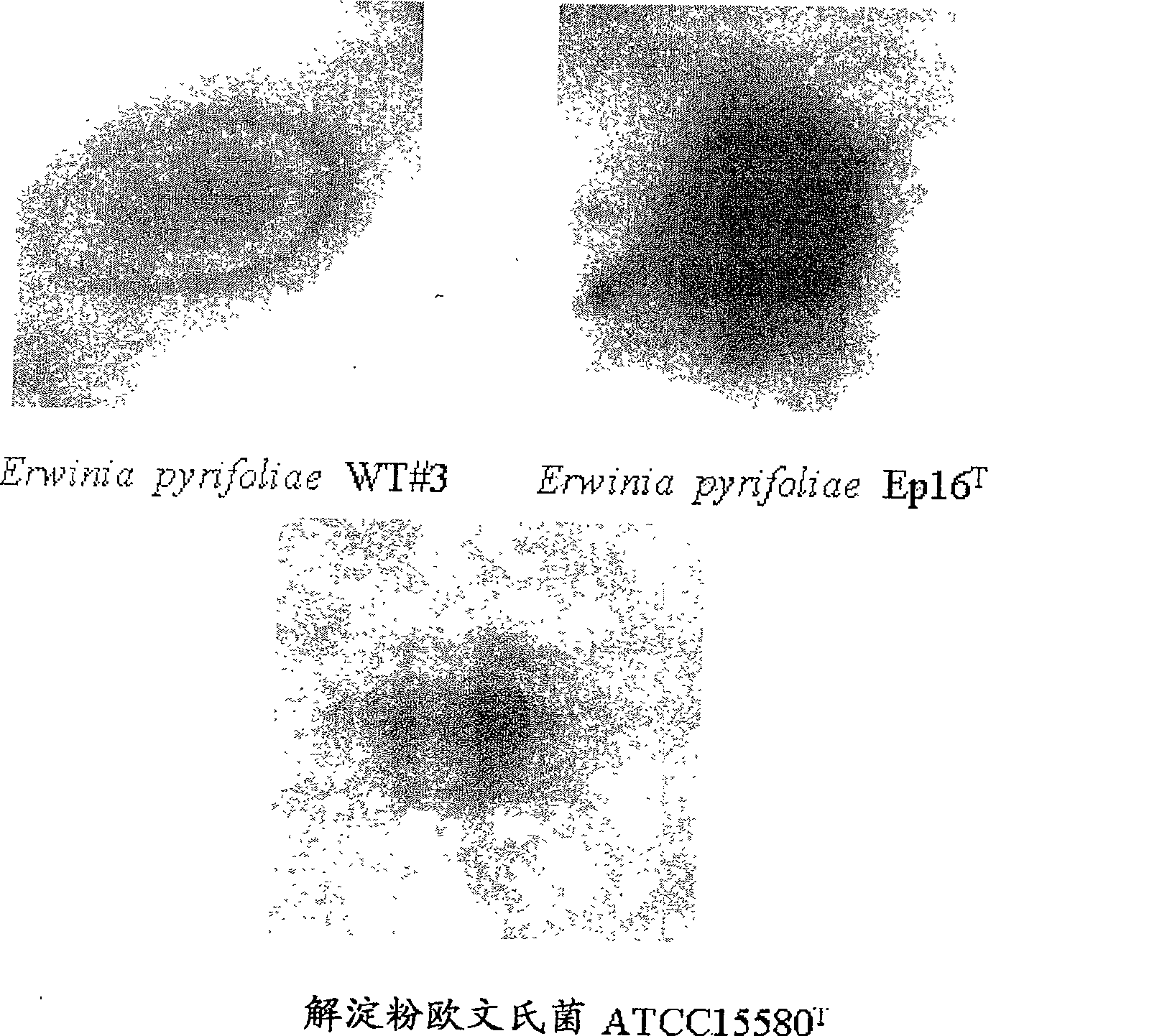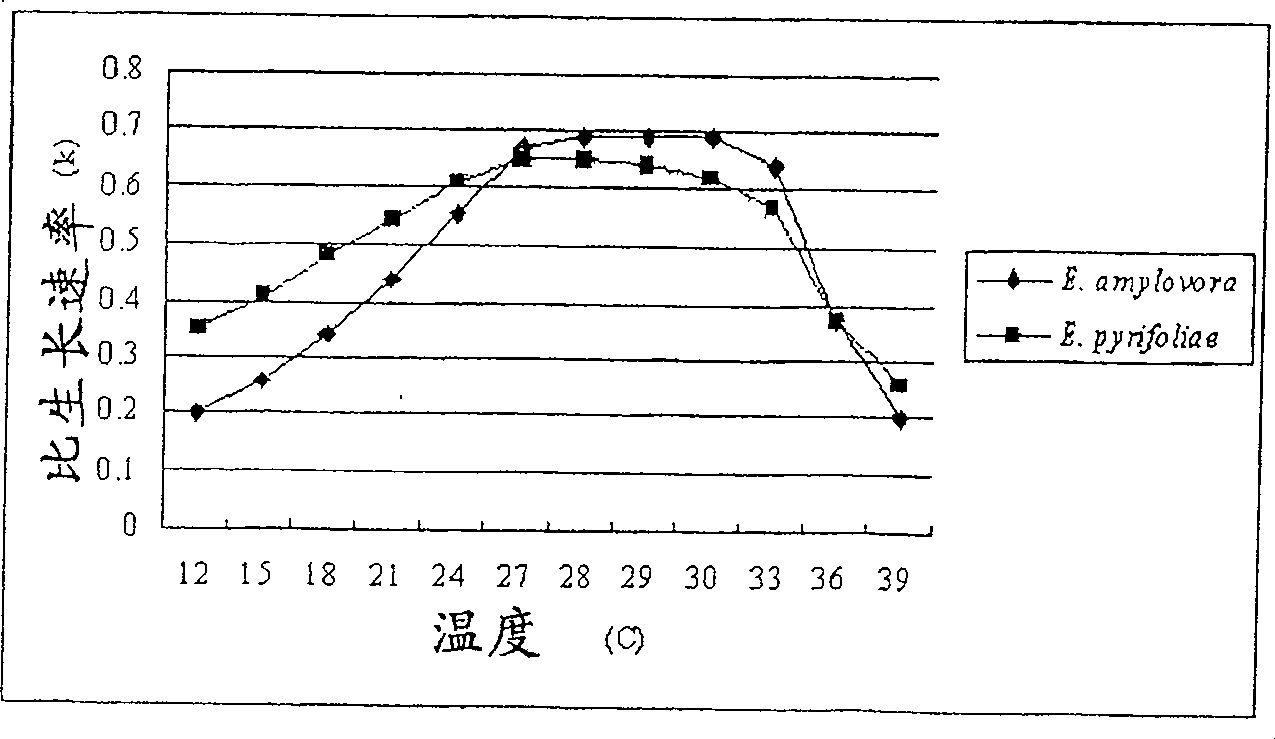New biopesticide using gene from erwinia pyrifoliaeWT#3, novel pathogen that affects asian pear trees
A pathogen and gene technology, applied in the field of new biological pesticides, can solve the problem that pests are not recognized
- Summary
- Abstract
- Description
- Claims
- Application Information
AI Technical Summary
Problems solved by technology
Method used
Image
Examples
Embodiment 1
[0046] Embodiment 1: Isolation and identification of new bacterial strains
[0047] 1) Physiological / biochemical assays based on Schaad's experimental guidelines and Bergey's manual
[0048] In order to identify pathogenic bacteria from damaged parts infected by necrosis on Chunchon (Kangwon Province, Korea) orchard pears, based on Schaad's experimental guidance [Schaad, N.W. 1988. Preliminary identification of common genera. Ed. N.W. Schaad. American Phytopathological Society, Minnesot. PP.44-59] and Bergey's Handbook [Lelliott, R.A. and Dickey, R.S. 1984. Erwinia genus. In: Bergey Handbook of Systematic Bacteriology vol.1, pp.469-476, Williams and Willkins Co., Baltimore / London] performed different physiological and biochemical tests, as shown in Table 1 below.
[0049] Table 1
[0050]
[0051] Overall, the results of the analysis showed that this strain was superior to Erwiniapyrifoliae strain Ep16 in physiological assays (e.g., liquefaction of gelatin, motility in ...
Embodiment 2
[0099] Example 2: from Erwinia pyrifoliae WT # 3 that triggers plant hypersensitivity Properties of specific proteins and their coding genes
[0100] 1) Analysis of plant HR-induced genes from Erwinia pyrifoliaeWT # 3
[0101] To analyze genes encoding specific proteins that induce allergic responses in plants, the total DNA of Erwiniapyrifoliae WT #3 was incubated at 37°C to ensure its partial digestion by Sau3 AI. Then take 1 μl of DNA electrophoresis every 1 hour to check whether it is properly digested, and the result shows that the digestion of about 6 hours is the most suitable. The total DNA thus treated was prepared as insert DNA and ligated into the BamHI polylinker site of the cloning vector pLAFR3 using DNA ligase by incubation at 14°C for 12 hours. Pass the complete plasmid DNA ligated with insert DNA and vector through CaCl 2 Transformation method Transformation into E. coli (HB101). Then, the Escherichia coli strain was cultured on a Luria agar medium cont...
Embodiment 3
[0141] Embodiment 3: use the biological activity that plant HR inducible protein (Pioneer) carries out Research
[0142] 1) Control effect on cucumber powdery mildew (Sphaerotheca fuliginea)
[0143] To evaluate the control effect of Pioneer against powdery mildew, the gene encoding plant HR-induced protein was cloned into pKEP3 vector to purify the protein.
[0144] Cucumbers were grown using the conventional "rain-protecting" method prevalent on farms. Test material was administered based on a 3-repeat randomized complete block design. Cucumber stems and leaves were treated with HR-induced protein Pioneer at a dose of 20 μg / ml recommended by EDEN Bioscience.
[0145] EDEN Bioscience at the same dose As a control, the locally produced Fenarimol (chemical pesticide) was also applied according to the instructions for comparison. The processing method is as follows:
[0146] (1) 3 treatments: after the early stage of powdery mildew (Sphaerotheca fuliginea), use Pioneer...
PUM
 Login to View More
Login to View More Abstract
Description
Claims
Application Information
 Login to View More
Login to View More - R&D
- Intellectual Property
- Life Sciences
- Materials
- Tech Scout
- Unparalleled Data Quality
- Higher Quality Content
- 60% Fewer Hallucinations
Browse by: Latest US Patents, China's latest patents, Technical Efficacy Thesaurus, Application Domain, Technology Topic, Popular Technical Reports.
© 2025 PatSnap. All rights reserved.Legal|Privacy policy|Modern Slavery Act Transparency Statement|Sitemap|About US| Contact US: help@patsnap.com



